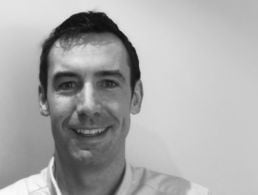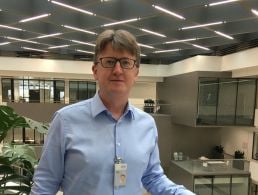Accenture’s John Moriarty discusses his career in UX design and how he deals with the daunting challenge of a constantly changing industry.
Fjord is a design and innovation consultancy that was acquired by Accenture in 2013. After working in roles in Ireland and the US, John Moriarty became a design director with the business based at The Dock, Accenture’s innovation hub in Dublin.
In school, his favourite subjects were art and engineering and when his uncle who was a guidance counsellor told him that design sits in the middle of both of these areas, Moriarty knew that was what he wanted to do.
He has now been with Fjord for five years and told SiliconRepublic.com about the variety within his role due to the fact that design is in a constant state of flux.
‘To be a designer today means being comfortable with change’
– JOHN MORIARTY
What education and other jobs led you to the role you now have?
I studied industrial design in the National College of Art and Design (NCAD). I found it to be a great course that gives a very solid grounding in a lot of core principles that I still use to this day – conducting research to understand users and technology and then take an iterative approach to develop and test solutions that address the problem to be solved.
After NCAD I worked with Design Partners in Bray, Co Wicklow for several years. This gave me the opportunity to work with global clients designing products that are still being sold in stores around the world today.
I always had an itch for user experience (UX), so after a few years I joined a start-up in the aviation space. I was responsible for leading the design of the hardware and user interface for an in-flight entertainment system. It was fantastic to see designs go from sketches to products being flown in planes.
After the start-up, I returned to Design Partners to set up their first satellite office in San Francisco. Being in the Bay Area, it was a great opportunity to develop the UX side of the business and my own skills in this area.
My role was split between studio leadership, design and business development. After my daughter was born, we decided to move back to Dublin from San Francisco, and I was made redundant. This was a pivotal moment for me as I decided to make the jump and fully commit to UX. I worked initially with education technology company HMH in Dublin, designing digital learning products for the US school system.
After some time in HMH, Fjord approached me about a role in their new studio in The Dock, Accenture’s flagship R&D and global innovation centre. The mix of a multidisciplinary innovation environment and emerging technologies was compelling. Add to that the opportunity to work with the calibre of clients in Accenture and it was a no-brainer for me. That was five years ago now and I haven’t looked back!
What were the biggest challenges you encountered on your career path?
The design industry is in a constant state of flux and the boundaries of what defines design are getting blurrier all the time. To be a designer today means being comfortable with change and remaining adaptable. It means knowing that things that got you to where you are today aren’t necessarily the things that will get you to where you’re going next. This is a continual challenge for many designers today and it can be daunting at times.
To deal with this I believe that optimism, a sense of curiosity and an open mindset are crucial. I also believe that almost any problem can be broken down and viewed as a design challenge. We have the training and methodologies to tackle complexity and ambiguity and that can equally be applied to how we approach our own careers.
Was there anyone who was particularly influential as your career developed?
It’s a bit cheesy, but I have to say my parents! My father was an engineer by training and gave me a technical and analytical perspective on the world while my mother really nurtured my creative, questioning side. Good design is often a combination of intellect and intuition and I think there is a direct line back to both of them in this regard.
What do you enjoy about your job?
As design director, my role is quite varied. On any given day my time is divided between supporting design on projects, defining product strategy with leadership and managing our team – making sure they have everything they need to be successful.
It’s a real privilege to work and learn alongside so many talented people. This includes our own designers and also those from other disciplines such as analytics and AI, product strategy and software engineering.
I love the variety of the work and clients we get to work with. As an innovation centre, we solve problems that impact some of the biggest brands in the world. It’s very rewarding to create work that has such scale and impact. Our team is currently working on projects from consumer goods to sustainability and public services. I love that each day I face new challenges that push me and challenge me. I’m still amazed that I get paid to do this for a living.
What aspects of your personality do you feel make you suited to this job?
I think staying optimistic is an inherent trait for many designers but I think it’s especially critical in an innovation centre where we are inventing new ways to do things. This is also important as a design leader, as people look to you and if you’re not excited then you can’t expect them to be. I think a sense of curiosity about how things work and a desire and impatience for products and services to be better is also valuable.
How did Accenture support you on your career path?
Accenture really values learning and development and invests in this. Last year our design leadership team completed a design management diploma run by Design Skillnet. It was a great opportunity for us to come together and reflect on how we work and learn some new skills. Also, we have access to amazing training resources and a wider community as part of the Fjord network of 1,200 designers within Accenture globally.
In terms of advancing your career, taking initiative is really rewarded in Accenture so if you have an idea, you will generally get the support from leadership.
What advice would you give to those considering a career in UX design?
There hasn’t been a better time to be a designer than today in terms of opportunities available, but it can be daunting to know where to start.
I always recommend reaching out to people in the industry to ask for advice. People are generally happy to give advice as we have all been in the same shoes at some point.




